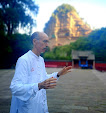When I was in Hong Kong in August of 2012 I went to pay my respects at his grave.
Ip Man's grave is found on a hillside behind Fung Ying Seen Koon temple in Fanling, Hong Kong. At the time I was staying in Kowloon and Fanling was quite a distance away. Fortunately, Hong Kong has an excellent subway system that is easy to use. I left my hotel early one morning and walked 15 minutes to the subway station. It was quite hot and humid and I was a bit sweaty by the time I got to the station. Fortunately it was much cooler in the subway. From my starting point I had to make two transfers on the subway to get to the train to Fanling. The ride was moderately crowded and at some point the subway train came above the ground so you could see the outlying area. When we arrived at the Fanling station I got off the train and walked on the overpass to Fung Ying Seen Koon temple which is nearby. Ip Man is buried in a graveyard behind the temple. There's a path to the graveyard and along the path are a couple marker's pointing you toward his grave. On this day the paths were covered in branches and leaves left by a typhoon that had passed through Hong Kong two days before. The debris on the path made it seem like you were hiking in the jungle and the high humidity and mosquitoes added to that effect. Other than the few signs pointing in the right direction there's nothing to tell you when you get to the grave. Ip Man did have a large gravesite compared to the others and it was swept clean. All the other graves were covered in leaves. I got the impression that someone goes there regularly to take care of it. Here are some pictures from the trip.
Fung Ying Seen Koon temple
The starting point
The path blocked by bamboo and littered with leaves.
A sign pointing the way.
More leaves on the path.
Ip Man's grave
Ip Man's picture on his grave.












